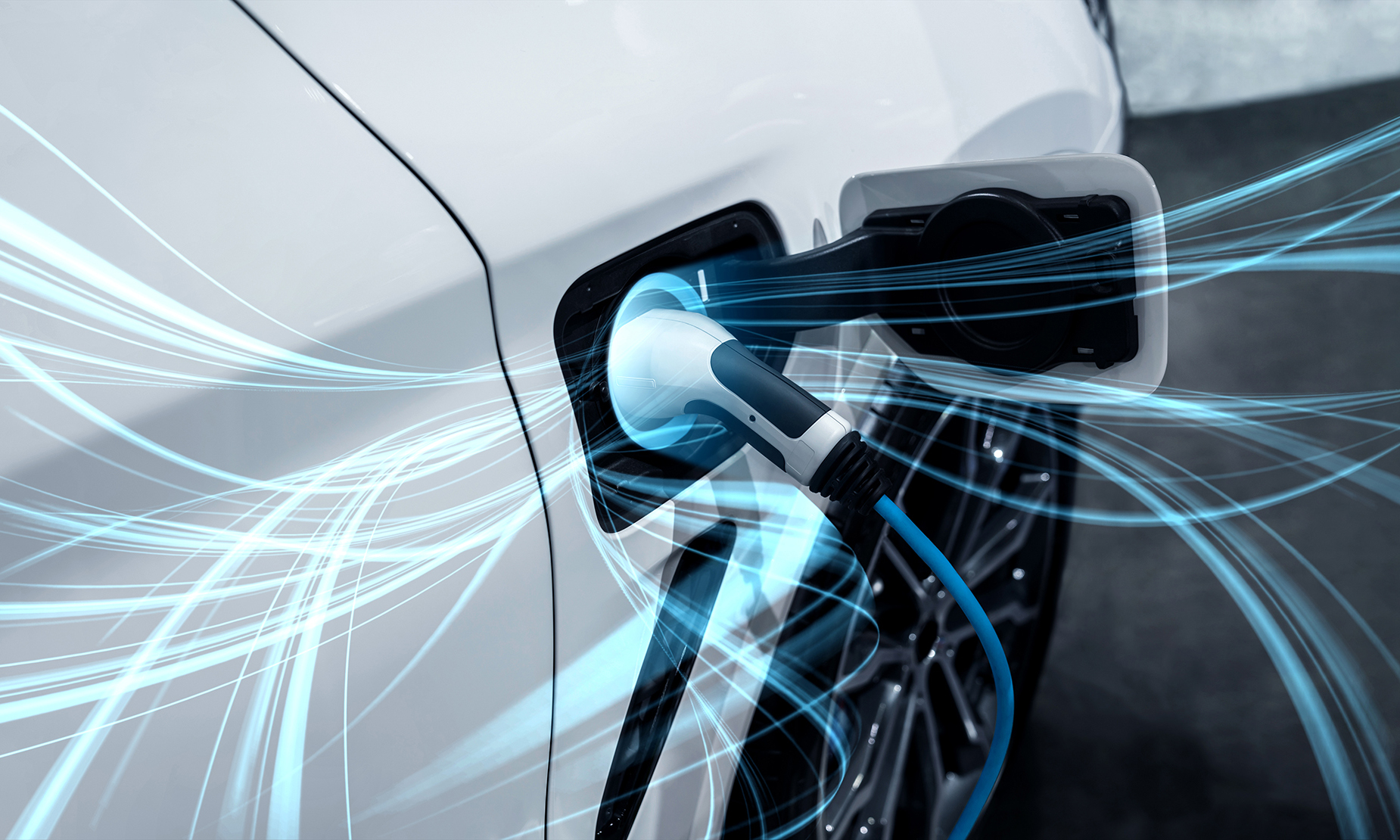
The EV influence: The changing needs of today’s consumer

The growing popularity of electric vehicles (EVs) has led to a new buying experience for customers and is influencing a change in driving behaviors. Brands are working harder to understand the needs of this new generation of consumers and manage their expectations more effectively. In the following interview, Robert M. Häusler, Director New Retail Model and EV Strategy at Global Sales, MSX, discusses how businesses must adapt to changing consumer profiles and attitudes towards EVs.
“The automotive industry today competes within a technology-driven, experience-rich environment in which EV companies are thriving.”
How have EVs inspired brands to change the way they appeal to consumers and what are ‘new generation’ customers?
Historically, cars were sold on their performance and reliability. Manufacturers focused on changing the consumer’s attitude towards their products or tailoring their marketing to their ‘ideal’ customer, rather than making the product fit the consumer. While some of these approaches play a role today, a user-centric perspective is now crucial. Businesses must understand the needs of consumers and tailor their offerings accordingly.
In the early days of EV sales, buyers were often higher-income customers willing to pay more or experience the restrictions of lower-range travel to own a vehicle. But the EV customer persona has changed. The buying demographic has grown from this niche audience to a larger group of consumers with more mainstream values and expectations. Millennials are 2.5 times more likely to be early adopters of technology than older generations, being both drivers and consumers of it. And US-based research from Pew Research Center, conducted in 2019, found that 30% of millennials live with a spouse and their own child. This generation is made up of people who not only demand the latest technology, but who have also reached a more family-oriented, financially stable period in their lives. For this reason, it’s a highly influential demographic that could represent a tipping point for many brands’ EV success.
Today’s EV companies are embracing the values of this new generation with their customer-oriented products and services. Tesla’s business model relies on a direct-to-customer approach, with a seamless, low-effort sales journey, for example. And Polestar offers a hassle-free online purchase process alongside a mobile app which gives owners access to a range of connected features.
When do you expect to own an electric vehicle?
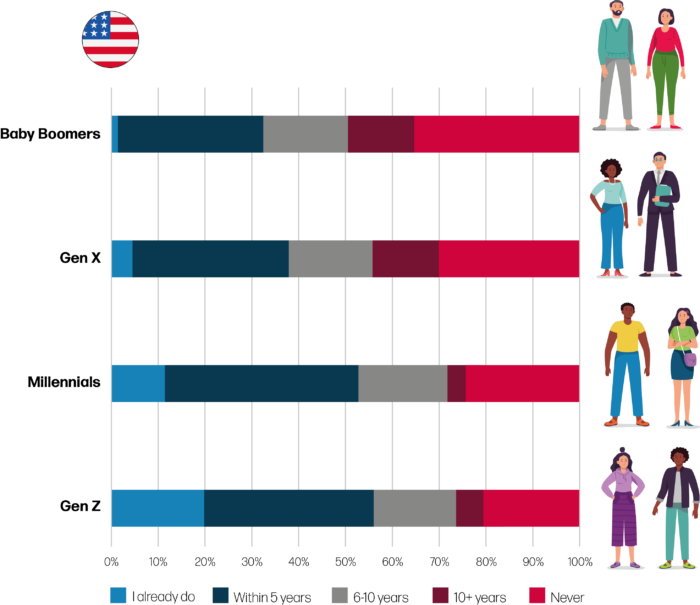
Source: Jerry 2022 State of the American Driver
When do you expect to own an electric vehicle?
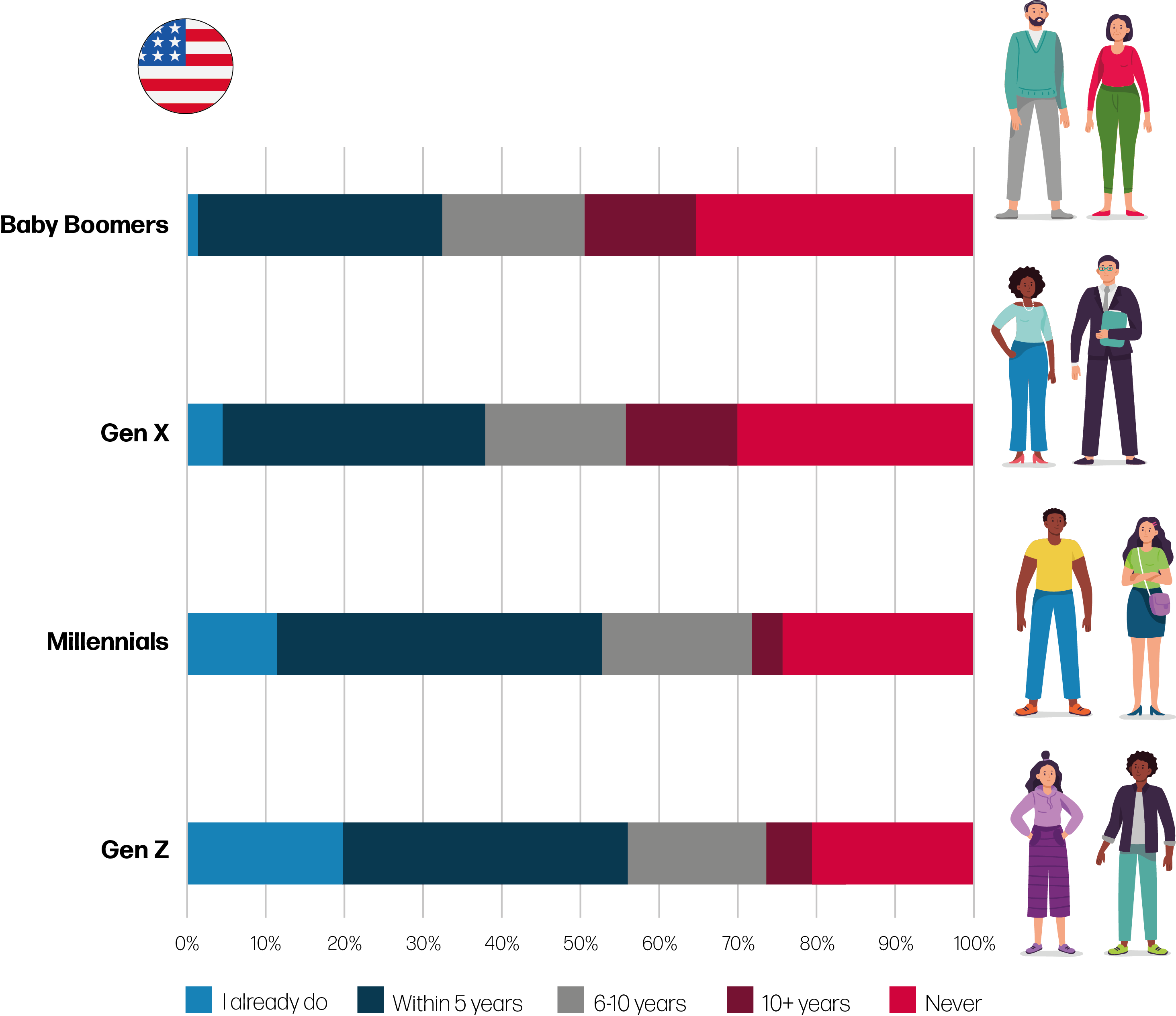
Source: Jerry 2022 State of the American Driver
How do EV-buyer personas, and therefore customer experiences, differ from those of ICE consumers?
The automotive industry today competes within a technology-driven, experience-rich environment in which EV companies are thriving. EV customers value different product features than ICE drivers, and the way they think about using their vehicle is also different. They may plan their travel around charging availability, for example, and this affects the way manufacturers position their products. When identifying buyer personas, brands can align EV customers’ attitudes, thoughts, and behaviors to their buying behaviors and intentions.
Various factors contribute to consumers’ interest in purchasing an EV, such as their awareness and attitude towards the vehicles. Although positive attitudes towards electric vehicles may make consumers more inclined to make a purchase, there are still many other factors involved. The availability of local charging infrastructure, and the capability to charge a vehicle at home, are crucial for an EV to be a feasible purchase for most consumers. Furthermore, EVs are often more expensive than their internal combustion engine counterparts, which may mean some consumers are unable to afford these vehicles. Additionally, the influence of external sources, such as information online and the opinions of other people can impact on a consumer’s plan to purchase an EV.
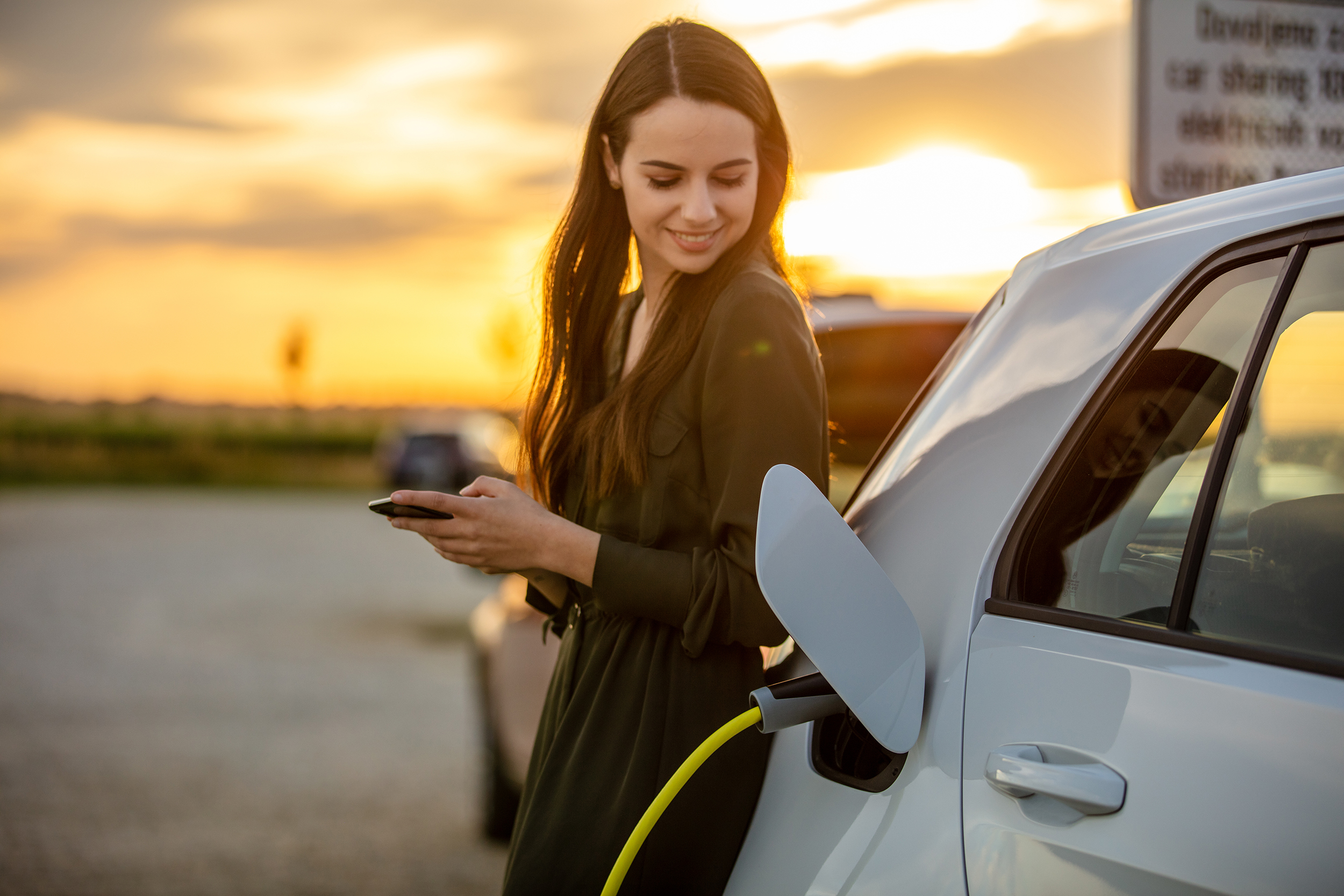
The association between EVs and a greener future has boosted consumers’ purchase intentions, and research by AlixPartners shows an increase in battery electric vehicle (BEV) interest can also be attributed to the influence of family and friends. Meanwhile, the concept of being part of a club or community is also persuading potential buyers. In these communities, other EV users act as advocates, helping those in earlier stages of the buying process by sharing their knowledge across social media channels or community forums. Many brands now recognize the importance of these communities in helping prospective buyers understand EVs and in alleviating concerns about their buying decisions.
How can brands extend that community to a wider audience?
One UK-based survey found that over 90% of EV and PHEV drivers can charge their vehicle at home. These figures suggest that people without access to home charging are less inclined to consider an EV, highlighting one of the challenges the industry has yet to overcome.
But similar challenges were experienced by early users of the first gasoline cars who struggled to find fuel as suppliers were limited. And in the early days of mobile phones, hardware costs and network rates were high compared to the affordable contracts of today. In future, EV contracts may deliver low-cost hardware and bundled, flat rates for elements such as charging. And they’ll offer more additional benefits, such as in-vehicle apps, community platforms and personalization features.
EV brands must establish a deep understanding of their audience, and services and products must be easy to consume. Brands will need to offer promotions for home or public charging stations, making charging affordable and convenient. The industry is already welcoming innovative ways to ease the issue of charging. Chinese electric mobility company NIO, for example, has introduced battery swapping, enabling a driver to easily swap a drained battery for a fully charged one in minutes. Ultimately, brands are building cost-effective, scalable solutions that can be adapted to the industry’s changing needs and offer sustainable new sources of revenue.
Percentage of EV owners indicating an information source is ‘essential’ or ‘very valuable’ in making a purchase decision

Source: Plug-In America The Expanding EV Market: Observations in a year of growth
Percentage of EV owners indicating an information source is ‘essential’ or ‘very valuable’ in making a purchase decision
Source: Plug-In America The Expanding EV Market: Observations in a year of growth
What is the relevance of customer touchpoints and how do they contribute to a better EV-buying journey?
OEMs face many challenges in their transition to a world of electric and autonomous vehicles, new mobility models and greater connectivity. Transformation is complex and expensive, and it’s hard to know which investments will pay off, leaving some businesses nervous about the choices they make.
But digitalization, new consumer behaviors and better information access have led to an explosion in customer touchpoints, and effective analysis of these can improve customer experiences and boost revenue. All touchpoints are important in generating enthusiasm and emotion, but today, digital options are increasingly valuable. The AlixPartners 2021 EV Consumer Sentiment Survey reveals that BEV buyers are around three times more likely to prefer an online experience than those who are unlikely to buy a BEV.
Touchpoint analysis involves the creation of a customer touchpoint map, on which all contact points are categorized according to criteria such as manufacturer, regional and local conditions, and industry specifics. Touchpoint mapping assesses each contact to determine how well it meets EV customer requirements and how effective an experience it offers. This way, the business can tailor its touchpoints to successfully influence the customer at crucial moments in their buying journey.
Digital touchpoints such as chatbots, voice-bots, or avatars are vital in easing customer communication pressures on businesses, gathering data and generating leads. They use artificial intelligence to detect keywords for smarter, more accurate responses to customer enquiries, helping people book a test drive or browse product ranges, for example. Bots also offer immediate support around the clock and increase brand awareness through targeted offers.
The speed at which EVs have progressed in a relatively short time is a clear indicator of the scale of innovation the industry can expect in the years to come. Early EVs had a range of around 100 km and now some brands, such as Lucid Group and Mercedes-Benz, are developing vehicles with a range of up to 1,000 km. We’ll also see many new charging options, greater connectivity, more transparent data, autonomy, and convenience. These factors, and the undeniable benefits of EVs to the environment, are all contributing to the rapid rise in EV acceptance and sales.
About the Author:
Robert M. Häusler
Director New Retail Model and Electric Vehicle (EV) Strategy
Robert M. Häusler joined MSX International in early 2022 as Director New Retail Model and Electric Vehicle (EV) Strategy. His responsibilities include leading the company’s electric vehicle and new retail expansion into Europe, establishing the new electric performance portfolio, driving sales and revenue and delivering outstanding customer experience. Prior to joining MSX, Robert gained a wealth of consultancy experience within the automotive sector in senior management roles within premium OEMs. Robert is based in Munich, Germany, and can be reached at rhaeusler@msxi.com.




